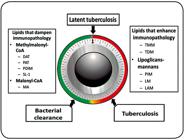Abstract:
The lipid-rich cell wall of Mycobacterium tuberculosis is a dynamic structure that is involved in the regulation of the transport of nutrients, toxic host-cell effector molecules, and anti-tuberculosis drugs. It is therefore postulated to contribute to the long-term bacterial survival in an infected human host. Accumulating evidence suggests that M. tuberculosis remodels the lipid composition of the cell wall as an adaptive mechanism against host-imposed stress. Some of these lipid species (trehalose dimycolate, diacylated sulphoglycolipid, and mannan-based lipoglycans) trigger an immunopathologic response, whereas others (phthiocerol dimycocerosate, mycolic acids, sulpholipid-1, and di-and polyacyltrehalose) appear to dampen the immune responses. These lipids appear to be coordinately expressed in the cell wall of M. tuberculosis during different phases of infection, ultimately determining the clinical fate of the infection. This review summarizes the current state of knowledge on the metabolism, transport, and homeostatic or immunostatic regulation of the cell wall lipids, and their orchestrated interaction with host immune responses that results in bacterial clearance, persistence, or tuberculosis.
Keywords:
Mycobacterium tuberculosis; Lipids; Immune response

 Thumbnail
Thumbnail
 Thumbnail
Thumbnail

